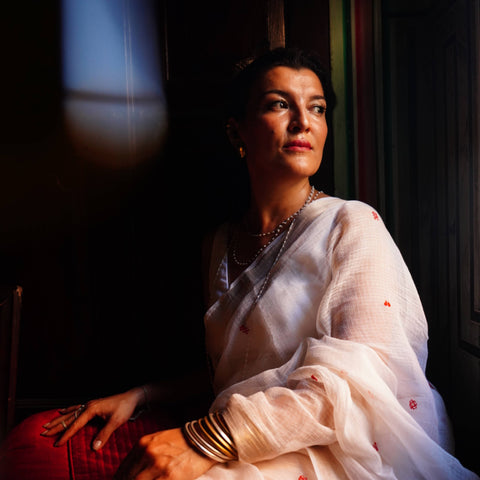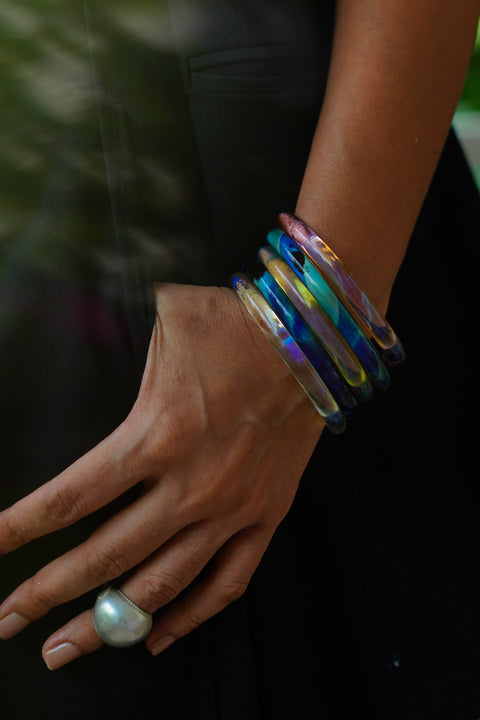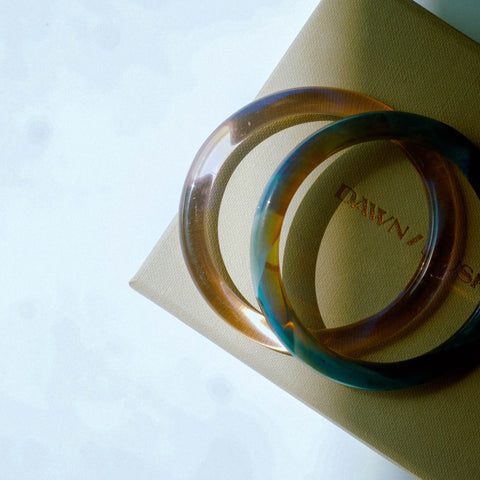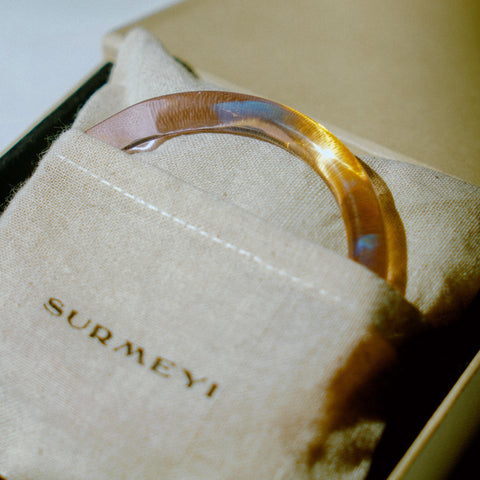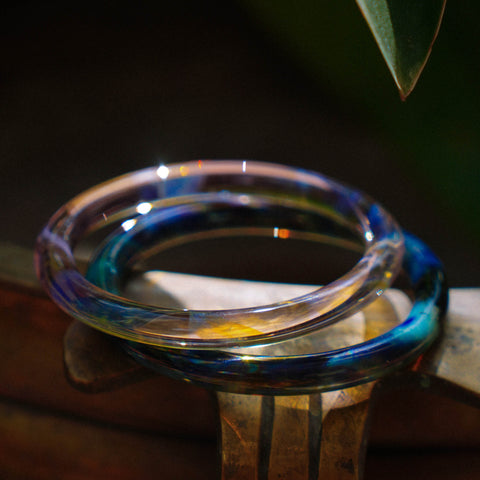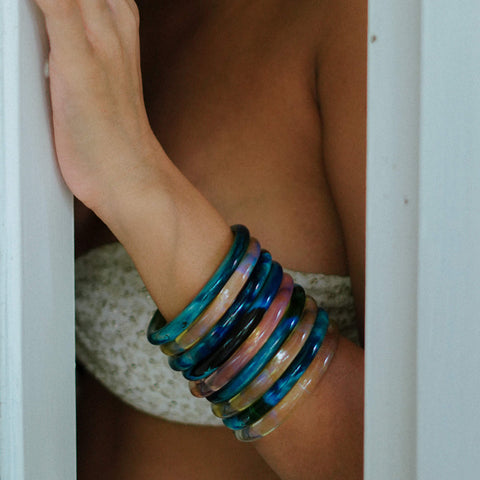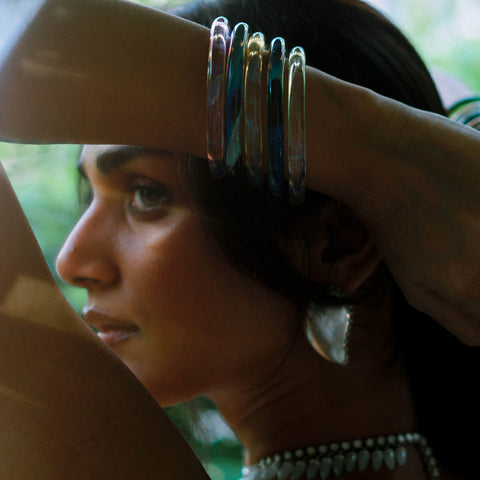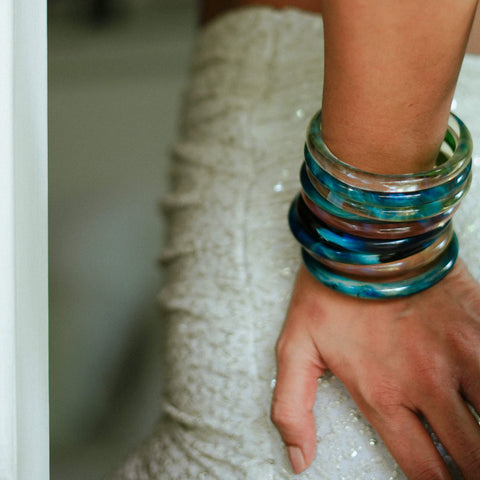In a world where boundaries often define us, what if we could transcend them? At Surmeyi, we believe that true connection lies beyond cultural confines, rooted in our shared experiences and emotions. In this conversation with Feruza, we explore how our shared humanity can create a beautiful world without borders. Even though it may never be a reality elsewhere, between us and Feruza, this world already exists.
And we consider ourselves incredibly lucky to have people like Feruza in our community who help shape this conversation for us. Feruza Abdullaeva, also known as @azeema.nur, is an Uzbekistani artist, a Bollywood buff, and a fearless ambassador at @fearlesscollective. She currently resides in San Diego and is not only a dear customer but also a cherished friend.
✦✦✦✦
Q: Feruza, let’s start at the beginning. Where does your story with art begin?
A: I was born in Uzbekistan, a place where textiles, embroidery, and the rhythm of making things by hand were part of everyday life. My earliest memories are of sitting beside my grandmother, watching her stitch intricate patterns with gold zari into fabric. I didn’t understand it then, but she wasn’t just sewing—she was preserving something. A story, a memory, a feeling.
Growing up, I was surrounded by this quiet, intentional kind of beauty—the kind that isn’t loud but is always present. When I started my journey as an artist, integrating these stitches into my paintings wasn’t a conscious decision. It felt more like a continuation of something that had already been set in motion before me.
Q: You’ve spoken about zardozi as a way of storytelling. What does it mean to you?
A: Zardozi has history stitched into it. It’s not just embroidery—it’s time, held in place by a needle and thread. Every piece carries the hands of the artisan, their thoughts, their hesitations, their mastery. I love the weight of it, both physically and emotionally. The way it shimmers but also holds something deeper, something human.
What drew me to it is that it feels like an act of remembering. Every stitch is a connection—to those who came before, to those who will come after. And that’s the beauty of craft: it is never just yours. It exists beyond you.
Q: Tell us about your connection with India.
A: As a child in post-Soviet Uzbekistan, I grew up watching The Mahabharata dubbed in Uzbek on the Indian channel Doordarshan. "Why do I have to watch this?" I would complain, confused by the constant talking and the strange golden headgear. But my grandmother, a devout and educated Muslim, would bribe me with wrinkled yellow apples preserved from the fall and promises of ice cream just to keep me seated.
Despite the differences in religion and culture, my grandmother saw no contradiction in exposing me to the wisdom of another civilization.
"This will be the most important film you'll ever see," she'd insist, her eyes alight with conviction. And so, I would dutifully settle into an old Viennese chair, drawn into the rich tapestry of the story despite my reluctance. In those moments, I learned a profound lesson from my grandmother: "She was listening with her heart," I realized, "and she taught me to do the same."
That was only the beginning of my connection with India. Over time, I traveled there many times, forming close friendships that feel more like family. India is like home to me now.
Q: And then there are mangoes. They seem to follow you in unexpected ways.
A: I hadn’t had my first mango until a few years ago when visiting a friend in India during the summer. And now, mangoes have a way of finding me, no matter where I am. I never seek them out, but they always appear—in conversations, in memories, in gifts from strangers, even on my Instagram feed—and that’s how I found Surmeyi.
I have shared so many profound moments with friends over mangoes that they have become markers of time. They are about presence, about sweetness, about something fleeting yet unforgettable. And maybe that’s why they keep appearing—they remind me to notice, to hold onto the small things. They are about meeting at the heart of an emotion.
Q: Say more?
A: It means that when we truly feel something, we are no longer separate. We are no longer divided by culture, language, or geography.
And so when we meet at the heart of an emotion, then everything belongs to everyone. Then there are no boundaries, there are no rules. There is no appropriation. There is no me, there is no you. There’s everyone. And everything belongs to everyone. In beauty, in love, and in openness. Much like what you all do at Surmeyi.
Q: How does this idea translate into your connection with Surmeyi?
A: Surmeyi is not just about jewelry. It’s about memory, about sentiment, about carrying something that feels like home—even if home is a place that keeps shifting. Jewelry, like embroidery, holds onto things. It remembers for us.
I think about adornment as a language. What we wear, how we wear it, what we choose to keep close—it all speaks. And in Surmeyi, I see that intention. It’s not just about designing something beautiful, but about holding something true.
In a way, it’s all the same thread. Zardozi, mangoes, jewelry—they are all ways of remembering, of belonging. We carry what matters with us, in the things we make, in the things we wear, in the things we love.
Q: If you had to describe your journey so far in one sentence?
A: A journey of returning—to stitches, to stories, to the things that never really leave us.

